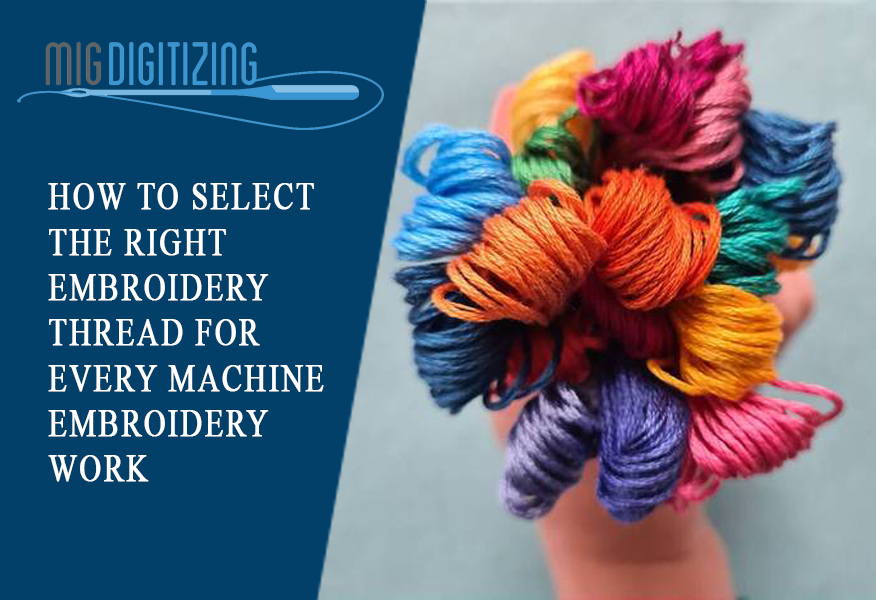
Who doesn’t a beautifully crafted piece of artwork having an amazing embroidery design? Everyone loves it. But have you wondered what goes on behind the scene? How these amazing piece of vector artwork that you see on different fabric material are made?
It’s the raw material that plays a major role in the making of these embroidery designs. One component that is crucial to pick the right one is the “Embroidery Thread”.
Don’t get overwhelmed! It’s easy and you can do it too. All you need is to have the knowledge about picking up the right embroidery thread for your next embroidery project.
The trick about creating a masterpiece is simple - choose the right thread for embroidery. To make it simple, we’ve listed down the components for selecting the right thread.
Let’s get started!
Choose the Right Thread Weight
Believe it or not, the weight of the thread plays a major role when doing the embroidery. People often ignore the importance of choosing the right embroidery thread.
To make it simple, a higher thread-weight means that the thread would be thinner and finer. Similarly, a low-thread weight means that the thread will be thicker.
The sewing machines measure the thread in wt. The standard embroidery threads are usually finer, weighing between 30-40 wt. Nearly all the normal digital machines designs are made with the within this weight range of thread.
Apart from that, the higher weight thread like the 80 wt or 100 wt thread is ideal for heirloom embroidery.
Choose the Ideal Thread Type/Material
This factor is so far the most common factor when picking up the right embroidery thread. There are usually three common types of embroidery threads.
-
Rayon
-
Cotton
-
Polyester
-
Silk
-
Rayon
It is the most popular and common embroidery thread for the machine. It is due to the fact that the thread is easily available in the market coming in a variety of different vibrant colours. What else can be more comfortable?
The thread is made of rayon fibres, organic cellulose, and have a luxuriously soft touch. A major drawback to this is that it can fade over the period of time.
Cotton
It is the peak level of natural fibre. The best quality of cotton threads is made from long-staple Egyptian cotton. The thread is super strong and is free of lint.
Machine embroidery threads with cotton are ideal for quilting, redwork, bean and for embroidery designs such as cross-stitch and bean-stitch.
Polyester
Just like the name the thread is strong, shiny, vibrant, and easy to use. This thread has a special feature - the thread is bleach-resistant and it doesn’t fade.
This makes the thread ideal for embroidering material that requires a lot of washing such as towels and kid’s apparel.
There is also a special kind of thread in this category known as Trilobal thread. The threads are made of multiple filaments and the triangular shape helps them to shine more than the standard polyester and embroidery thread.
Silk
Silk is another great form of embroidery thread for a machine. It is another natural fibre that is strong and a shine that is unique in its own way.
The thread ways around between 100 wt. It is most-liked by quilters who love to make applique designs.
Speciality Threads
These are some other threads that are worth mentioning. These threads can help you to enhance your embroidery in many ways. Let’s check out!
Metallic Thread
The metallic embroidery thread comes in handy if you are looking to enhance your artwork. The thread is flat in shape.
Variegated Thread
The variegated thread comes in a variety of colours. And you can even have a multi-colour thread. Some of the threads are dyed while others come in distinct and bold colours. The variegated colour thread is ideal for making beautiful embroidery designs.
Still Have a Question
This is the basic information that you may need when you get into the embroidery digitizing field. It is better to use the right type of embroidery thread to make amazing designs.
If you are still confused or you have a question about the embroidery threads, feel free to reach out to us. Our customer care team endeavours to answer your questions within 24 hours.



